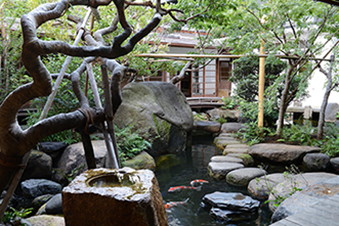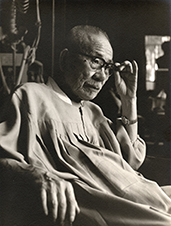 |
Focus features two in-depth reviews each month of fine art, architecture and design exhibitions and events at art museums, galleries and alternative spaces around Japan. The contributors are non-Japanese art critics living in Japan. |
|
|
 |
 |
 |
Bronzes Right at Home: The Asakura Museum of Sculpture
Michael Pronko |
 |
|
| The entrance area of the museum, built at Asakura's direction through the 1920s and '30s, flows in from the surrounding Yanaka streets. The decorative use of concrete was new at the time. Photo by Michael Pronko |
Fumio Asakura (1883-1964) was a leading figure in modern Japanese sculpture. A visit to the museum that occupies the building where he lived and worked is a delight after its recent restoration. The space is so vibrant that one feels as if Asakura is still there, talking about art, showing his recent works, and guiding you around his marvelous hybrid Western-Japanese residence.
Recently refurbished and reopened after a four-year hiatus, the Asakura Museum of Sculpture faithfully reflects the care the sculptor took in planning and designing his own studio and living quarters. Asakura began living here in 1907, expanding the structure little by little so as to accommodate his love of traditional Japanese architecture as well as the needs of a modern atelier for creating bronzes, some of them over two meters tall.
Asakura was the first sculptor to receive Japan's Order of Culture, and it is well deserved. Not only are his sculptures vital and compelling, but his home is itself a work of art. The building was registered as a National Tangible Cultural Property and the courtyard garden and roof garden were designated a National Place of Scenic Beauty.
The studio wing is built in concrete with high-ceilinged rooms, skylights, and a rooftop garden for growing vegetables and decorative plants and flowers. The walls are all lined with bookshelves or comfortable coverings. Asakura's personal library offers big easy chairs and art-deco lamps that tempt you to sit down and read for the rest of the afternoon. The open, airy spaces with parquet floors and large windows were meticulously conceived and surely well used.
 |
|
 |
|
|
|
| The inner garden, sublimely designed in traditional Japanese style, links the Western studio wing and the Japanese residential wing. Photo courtesy of the Asakura Museum |
|
Fumio Asakura in his studio, with a skeleton behind him. The atelier is large, with high ceilings and many windows that provide ample light, space and distance for viewing his works. Photo courtesy of the Asakura Museum |
In pleasing contrast, the residential section wraps around the other side of the central Japanese-style garden, its large pond stocked with some of the fattest carp in Tokyo. Everywhere, the detail on the woodwork is breathtaking. Each cut, split, or polished piece of wood was clearly chosen with care. Bamboo dividers, hidden niches, and split-floor landings meld with the tatami mats and exquisite wooden fixtures, an exhibit in themselves of the superb techniques of Japanese traditional home design.
A unique pleasure is to look out the windows from the western side to see the Japanese garden and sliding wooden doors of the residential wing. The opposite view from the Japanese side presents the sturdy, decorative concrete design of the atelier, reaching up three stories. Indeed, the architecture of the home and studio is so compelling that it takes an effort to shift your focus to the many bronze sculptures in the exhibit area.
"Gravekeeper" (1910), one of Asakura's larger sculptures. The pose and gaze are intense and remarkably realistic. Photo courtesy of the Asakura Museum |
|
"Time Passing" (1917). Delicate, light and alive, the poses of the nude bronzes convey a sense of being at ease quite unlike the formality of most statues before Asakura's time. The lightness of the pose contrasts with the weight of the bronze. Photo courtesy of the Asakura Museum |
|
"Dangling Cat" (1909). The numerous cat bronzes capture their subjects in actions that express their feline nature -- dangling from a hand, trapping a mouse, or stretching their back. Asakura kept many cats in his studios, always at hand to model for him. Photo courtesy of the Asakura Museum |
Asakura moved away from traditional Japanese sculpture techniques to work in a highly realistic mode that was truly avant-garde for the art world before World War II. His human images, most of them life-size, stare at you with a forceful presence. The bronze nudes, with natural poses rare in the Japan of his day, are erotic, graceful and alluring.
The museum also showcases Asakura's many cat sculptures. Though the cat motif will undoubtedly appeal to cute-loving visitors, these felines are caught in vigorous poses, ready to pounce or happily snagging a rat. Asakura's humor comes out as strongly with the cat bronzes as his intensity does with the human busts and larger sculptures. The main galleries allow enough distance to take in the biggest works, while cozier rooms let visitors get up close to the smaller ones.
A visit to the Asakura Museum can be followed or preceded with a stroll through the surrounding Yanaka district, home to many small workshops, traditional stores and tasteful new boutiques. In Yanaka, the artistic impulse is not just enclosed inside the studios, but spreads out through the neighborhood, which is surely why Asakura chose to build his intriguing live-work space there.
 |
|
| "Monkeys" (1925). Outside the museum, along the roof, and in the rooftop garden, sculptures adorn the grounds in unexpected places. Here, the monkeys seem intent on racing into the front door of the museum. Photo by Michael Pronko
|
 |
Asakura Museum of Sculpture
|
| |
(You must wear socks in this museum, so be prepared!)
18-10 Yanaka 7-chome, Taito-ku, Tokyo
Phone: 03-3821-4549
Open: 9:30 am to 4:30 pm, closed Monday and Friday
Access: 5 minutes' walk from the north exit of Nippori Station on the JR Yamanote Line |
 |
 |
Michael Pronko
Michael Pronko teaches American literature, film, art and music at Meiji Gakuin University. He has appeared on NHK, Sekai Ichiban Uketai Jugyo, and other TV programs. His publications include several textbooks and three collections of essays about Tokyo. He writes regular columns for Newsweek Japan, ST Shukan, The Japan Times, and for his own websites, Jazz in Japan and Essays on English in Japan. |
|
 |
|